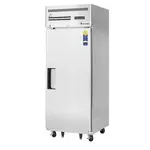Broccoli is a unique, healthy, and delicious vegetable loaded with several nutrients, minerals, and a lot of fiber. It can be used in several dishes encompassing multiple cuisines. Broccoli is quite a resilient vegetable and takes well to refrigeration and freezing. When bought fresh, broccoli can be refrigerated without affecting its properties for up to two weeks or more. But the real benefit of storing broccoli lies in freezing broccoli. Have you ever bought extra broccoli from the farmer’s market and wondered how to freeze broccoli or about freezing broccoli raw? The answer’s quite straightforward, you follow a method of blanching, flash freezing, and freezing to store broccoli for up to a year. This greatly increases the shelf life of the broccoli you’ve purchased and also helps in case you grow broccoli in your garden.
Cleaning Broccoli
Before you begin freezing broccoli, you need to clean it. Broccoli can contain mud, bugs, aphids, and sometimes even caterpillars, so it’s important to clean out broccoli before we discuss how to freeze broccoli. The first step is to cut off the woody stalks and its stems. You can cut away the central stem and set it aside. The broccoli stem is quite delicious and contains a lot of nutrition, however, the thick covering deters people from eating it. Though the stem might take some time in the pot to cook and soften up, the procedure is worth it.
Following the removal of the stem, you can peel it using a regular vegetable peeler and remove the thick outer covering. Proceed to cut the stem into small pieces between a quarter and half-inch thick for tossing along with the broccoli.
The entire broccoli head does not freeze efficiently, and this makes it important to cut the head into several florets before freezing broccoli. Individual florets cut up and thrown into a Ziploc take lesser freezer space as well. After separating the head into individual florets, take a bowl of room temperature brine water and soak the broccoli florets and stem slices in it for half an hour. This cleans out grime, dust, dirt, insects, and worms. Once the desired period passes, remove the broccoli, stem slices and wash them in cold water. Further, we look at how to blanch broccoli for freezing.
How to Blanch Broccoli for Freezing
Before we get to answering the core question about blanching, you may ask how to freeze broccoli without blanching or how to freeze broccoli raw. Unfortunately, storing broccoli raw or freezing broccoli unblanched will make it last in your fridge only for a couple of weeks. However, blanching and freezing broccoli can make it last up to a year in the freezer.
Blanching is the process of starting the cooking process and stopping it before it fully cooks. This aids in denaturing the enzymes present in the broccoli that can make it go bad. Once these enzymes are inactivated, freezing broccoli is quite a hassle-free process, as this extends the lifetime of the vegetable in your freezer. Blanching also makes sure the vitamins and minerals in the broccoli aren’t leeched off and lost. The process is essential for both storage and preserving the nutritional integrity of the vegetable. Blanching can be done by two methods:
● Water Blanching
● Steam Blanching
Both processes yield the same results and are efficient pre-treatment measures for freezing broccoli. Here’s how you can carry out blanching at home:
● Water Blanching
● Take a large vat with water and add salt to it.
● Bring the water to a constant boil.
● The process of blanching involves sudden heating of the vegetable to high temperatures to destroy the enzymes present in them.
● Take the prepared and cleaned florets of broccoli and drop them into the boiling vat of saline water.
● Now’s when you ask the question - how long to blanch broccoli for freezing? The answer’s two to three minutes. The period is short because you do not want to completely cook the broccoli. Between two and three minutes in boiling water is sufficient for all the enzymes to get denatured, and for all the vital nutrients to become locked in.
● If you’re worried about over-cooking the broccoli, be sure to use a timer so that you can be accurate with the process.
● Strain the broccoli from the water and set the florets aside for freezing.
● Steam Blanching
● You’ll need a large hard-bottomed vat and a straining basket to help steam blanch your broccoli.
● Add water until the bath is around a couple of inches deep.
● Place the straining basket, make sure it fits well within the confines of the vat and is supported by the rim.
● Bring the water to a boil and toss the cut florets of broccoli into the straining basket.
● Cover the vat with a lid and let the broccoli be steamed for up to five minutes.
● Use a timer and make sure you don’t overdo the steaming process.
● Once the broccoli has steamed for the apt period, remove the basket and set it aside for freezing.
Ice Bath Treatment
It’s essential to transfer the blanched broccoli into an ice bath immediately to cause rapid cooling. Prepare an ice bath by suspending ice cubes in a pot of water, and throw the blanched broccoli into the pot as soon as you’re done with the blanching process. The internal temperature of the broccoli can continue cooking the vegetable and cause the broccoli to become too soft or soggy. The ice bath prevents this by dropping both the surface and internal temperature to an ideal level before freezing broccoli. Make sure you give the pot a nice stir so that the florets are cooled down completely. Leave the florets in the ice bath for about three minutes and drain them.
Freezing Broccoli
The process of freezing broccoli involves two steps:
● Flash freezing
● Cold storage
Here are the methods on how to freeze broccoli:
● Flash Freezing
● Following the ice bath treatment, strain the broccoli florets and set them on a tray with a sheet of butter paper.
● Place them in the freezer for a couple of hours.
● This process freezes the water molecules in their existing orientation, helping the broccoli retain its color, freshness, and texture.
● Cold Storage
● Once you’ve flash frozen broccoli, you can proceed to remove it from the freezer and transfer it to a Ziploc or an airtight container.
● Labeling the contents of the packet or the container is an important step in cold storage. This helps you use up the broccoli before the end of its shelf life.
● Freezing broccoli will help you store it for at least a year.
Cooking with Frozen Broccoli
You can choose to either thaw out the frozen broccoli first, or just toss it in directly, depending on the kind of dish you intend on making. For foods that do not require too much moisture, pre-cooking the frozen broccoli is ideal. If you allow it to thaw out in the dish, it might become sodden. For salads and the like, you can just toss the broccoli right into the mix. The same goes for barbecues and roasts; the heat automatically thaws out the frozen florets. Do keep in mind that blanched and frozen broccoli does not take as long as fresh broccoli to cook, owing to the pre-treatment it has gone through.


















